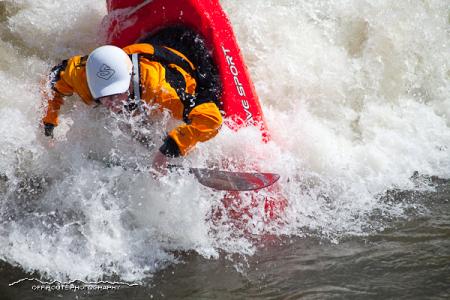Shoulder Injuries in Whitewater Paddling
Thanks in part to the recent extreme sport craze, whitewater kayaking has evolved dramatically in the last ten years. What was once a relatively unknown sport now ranks high on the list of the most popular adventure activities. It’s not uncommon these days to see kayaking videos or images of whitewater paddlers in TV commercials and magazine ads. Advances in boat design have helped push the sport to incredible levels. Just a decade ago the highest waterfalls run in a kayak were in the 30-40 foot range—now people are dropping falls well over 100 feet. Play-boating, or freestyle, has transitioned from simple two-dimensional tricks to dazzling three-dimensional maneuvers—flips, barrel rolls, and other aerials are now commonplace. Despite the changes in the sport of whitewater kayaking, however, one thing has stayed the same: anterior dislocation of the shoulder remains a common injury.
When the head of the humerus (upper arm) is forced out of its socket (scapula), the result is shoulder dislocation. The associated injury to the stabilizing ligaments and capsule of the shoulder is significant and places the individual at risk for repeated dislocations in the future. Anterior dislocation of the shoulder occurs most commonly when the arm is abducted, which means moved away from the body or overhead; and when reaching back, or “externally rotated.” This means that each time a boater executes an overextended brace, he or she is at risk for injury.
The correct technique for rolling a kayak (righting the boat from an inverted position) utilizes the torso and lower body to apply force to the paddle. If improper technique is used and sudden, unexpected force is applied to the paddle, shoulder injury can result. Beginning kayakers are more prone to this injury because of unrefined techniques; however, even the most skilled paddlers can encounter unexpected conditions that place them at risk. Along with the new style of play-boating, the speedy back-deck roll has become more popular; it allows maneuvers to become more fluid and thus helps a boater remain in a wave or hole longer. However, this style of roll places the shoulder in extreme abduction and external rotation.
If a boater experiences a dislocation, the shoulder may have more of a tendency to come out of joint in the future. The younger and more active someone is, the more he or she is at risk for repeated instability episodes (dislocations). In this scenario, the boater can avoid activities or positions that put the shoulder at risk, or have the ligaments and capsule of the shoulder repaired to restore stability to the shoulder and then return to overhead activities after complete healing.
The keys to avoiding injury include being aware of positions or activities that place the shoulder at risk. For example, a low brace is safer than a high brace. Proper roll execution is also important. Clearly, good technique is key; but shoulder stability and injury prevention can also be enhanced by a solid pre-season conditioning program that focuses on maximizing the strength and coordination of the shoulder girdle muscles—specifically the rotator cuff, upper back, and scapular-stabilizing musculature. Happy paddling.
Mark C. Diebert, M.D., is an orthopedic surgeon with Alpine Orthopedics and Sports Medicine, P.C. in Bozeman, 586-8029











